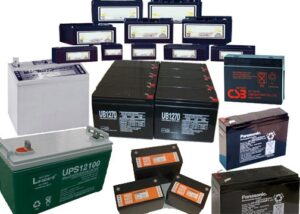UPS Batteries Frequently Asked Questions

Can I just go to the auto supply and get a 12 volt car battery?
You could, but then your supervisor should consider how quickly to terminate your employment. They are not the same design or performance. This is almost like suggesting that because I ride in airplanes for 150,000 miles a year that I should be able to fly one as well.
On to more serious questions… (but really, don’t try the above.)
What is the “ end of useful life” for a UPS battery?
The IEEE defines “end of useful life” for a UPS battery as the point when it can no longer supply 80 percent of its rated capacity in ampere-hours. When your battery reaches 80 percent of its rated capacity, the aging process accelerates, and the battery should be replaced.
Is there any difference between the batteries used by a smaller UPS, from 250 VA to 3 kVA, and the ones used by larger a UPS?
While basic battery technology and the risks to battery life remain the same regardless of UPS size, there are some inherent differences between large and small applications. A smaller UPS will typically have only one VRLA battery that supports the load and needs maintenance. As systems get larger, increasing battery capacity to support the load gets more complicated.
Larger systems may require multiple strings of batteries, introducing complexity to battery maintenance and support. Individual batteries must be monitored to prevent a single bad battery from taking down an entire string and putting the load at risk. Also, as systems get larger, wet-cell batteries become much more common.
I recently bought batteries for my UPS – how long can they sit in my facility unattended before they are installed?
Unfortunately, most customers will never ask this question. Instead of thinking of a UPS battery as a commodity that has a specific shelf life, they ignore this fact. Doing so; however, can present some very dire circumstances.
Below is a chart that shows a “Typical” correlation between temperature and shelf time. Keep in mind that batteries are not stored in a warehouse hooked up to a charging platform. Instead, the manufacturer is aware of these times as well and works under the assumption that batteries shipped will be installed in a timely manner.
So, don’t take for granted that your batteries can last and last in your own warehouse without attention and either:
- Purchase your batteries to be delivered at a time when they can be installed in a reasonable time period -or-
- Keep stored batteries in a cool, dry environment and have their voltage checked periodically to avoid discharge.
Ambient Temperature Typical Storage Time
0º F – 32º F 12 Months
33º F – 65º F 9 Months
66º F – 90º F 6 Months
91º F – 105º F 3 Months
106º F – 120º F 1 1/2 Months
As we get ready to put another year in the books do you find yourself with a bit of extra budget?
Whether that be the case or being told that Calendar 2018 CapEx is being moved forward, at ECS we can assist. Anything from a one-time service that has been pushed back to the possibility of replacing (or adding) equipment, we can make sure that whatever your needs are, they will be met with the most cost-effective solution possible.
Contact me today and we can work together to make it happen!

